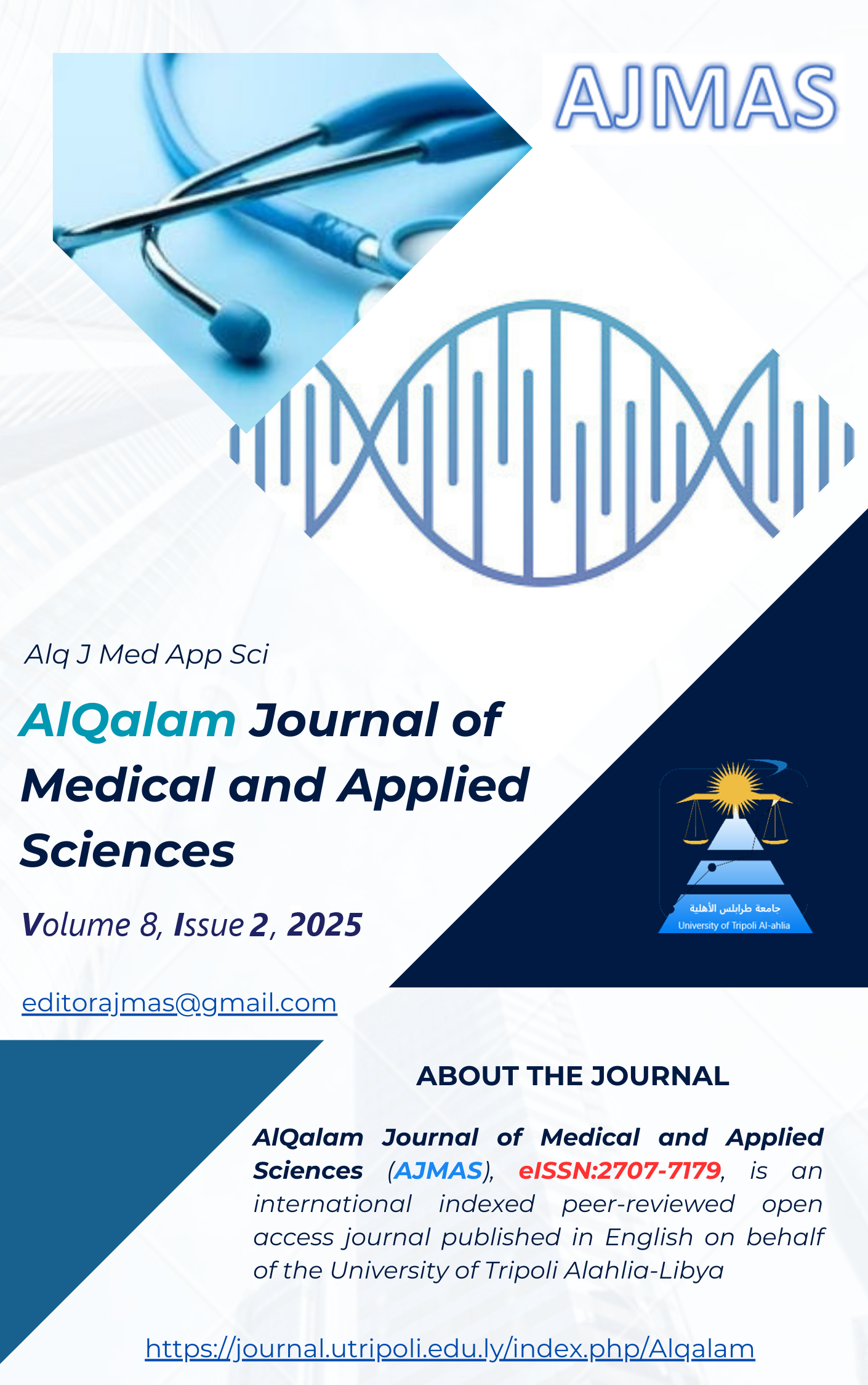Evaluation of Diabetic Cardiac Autonomic Neuropathy in Libyan Patients: Cross‐Link with Biochemical and Clinical Risk Factors
DOI:
https://doi.org/10.54361/ajmas.258203Keywords:
Type 2 Diabetes Mellitus, Pulse Rate, Metabolic Syndrome, Blood Pressure.Abstract
Diabetic cardiac autonomic neuropathy (DCAN) is a significant condition that affects cardiovascular health worldwide and is associated with increased morbidity and mortality rates. Therefore, early detection and management of DCAN are crucial for reducing the risk of cardiovascular disease among individuals with T2DM. Identifying this disorder can enhance patient outcomes and quality of life by minimizing the chances of serious complications. This cross-sectional study aims to identify diabetic individuals with DCAN and to investigate its relationship with various risk factors, including hyperglycemia, the duration of diabetes, the presence of peripheral somatic neuropathy, and diabetic microvascular complications. The study included 261 patients with T2DM, comprising 61.5% females and 38.5% males. Participants underwent cardiovascular testing and clinical evaluations to identify cases of cardiac autonomic neuropathy. Out of the 261 randomly selected patients, 82 were diagnosed with DCAN, resulting in a prevalence rate of 31.4%. The average age for female patients was 57.5 ± 0.7 years, while for male patients, it was 56.3 ± 1.2 years from the total recruited patients. In addition, there is a strong association between DCAN and clinical and biochemical parameters such as lipid profile, duration of diabetes, poor diabetic control, and presence of microalbuminuria in patients with DCAN and above 60 years old, compared to younger patients. The study highlighted a strong association between DCAN and factors such as poor glycemic control, prolonged diabetes duration, and the presence of chronic microvascular complications, including neuropathy, retinopathy, and nephropathy. These findings emphasize the importance of raising awareness and proactively assessing Libyan patients who are at risk for cardiovascular autonomic neuropathy. This is crucial to reduce the likelihood of recurrent acute cardiac complications, especially in patients undergoing emergency surgery without a prior diagnosis. It is vital to recognize this risk.
الاعتلال العصبي القلبي اللاإرادي السكري هو حالة مهمة تؤثر على صحة القلب والأوعية الدموية في جميع أنحاء العالم وترتبط بزيادة معدلات الاعتلال والوفيات. ولذلك، يعد الكشف المبكر عن اعتلال الأعصاب القلبية اللاإرادية السكري وعلاجه أمرًا بالغ الأهمية للحد من مخاطر الإصابة بأمراض القلب والأوعية الدموية بين مرضى السكري. يمكن أن يؤدي تحديد هذا الاضطراب إلى تحسين نتائج المرضى ونوعية حياتهم من خلال تقليل فرص حدوث مضاعفات خطيرة. تهدف هذه الدراسة المستعرضة إلى تحديد الأفراد المصابين بداء السكري الذين يعانون من الاعتلال العصبي القلبي اللاإرادي السكري والتحقيق في علاقته بعوامل الخطر المختلفة، بما في ذلك ارتفاع السكر في الدم، ومدة الإصابة بداء السكري، ووجود اعتلال الأعصاب الجسدية المحيطية، ومضاعفات الأوعية الدموية الدقيقة لمرضى السكري. شملت الدراسة 261 مريضًا بالسكري من النوع الثاني، منهم 61.5% من الإناث و38.5% من الذكور. خضع المشاركون لاختبارات القلب والأوعية الدموية والتقييمات السريرية لتحديد حالات الاعتلال العصبي القلبي اللاإرادي. من بين 261 مريضًا تم اختيارهم عشوائيًا، تم تشخيص 84 مريضًا بالاعتلال العصبي القلبي المستقل للقلب مما أدى إلى معدل انتشار بنسبة 32.2%. كان متوسط عمر المريضات الإناث 57.5 ±0.7 سنة، بينما كان متوسط عمر المرضى الذكور 56.3 ± 1.2 سنة من إجمالي المرضى الذين تم تجنيدهم. بالإضافة إلى ذلك، هناك ارتباطات قوية بين الاعتلال العصبي القلبي اللاإرادي السكري والمعايير السريرية والكيميائية الحيوية مثل ملف الدهون ومدة الإصابة بالسكري وضعف السيطرة على مرض السكري ووجود بيلة الألبومين الدقيقة لدى المرضى الذين يعانون من الاعتلال العصبي القلبي اللاإرادي السكري والذين تزيد أعمارهم عن 60 عامًا مقارنة بالمرضى الأصغر سنًا. سلطت الدراسة الضوء على وجود ارتباط قوي بين الاعتلال العصبي القلبي اللاإرادي السكري وعوامل مثل ضعف التحكم في نسبة السكر في الدم، ومدة مرض السكري الطويلة، ووجود مضاعفات مزمنة في الأوعية الدموية الدقيقة، بما في ذلك الاعتلال العصبي واعتلال الشبكية واعتلال الكلية. تؤكد هذه النتائج على ضرورة زيادة الوعي والتقييمات الاستباقية للمرضى الليبيين المعرضين لخطر الإصابة بالاعتلال العصبي اللاإرادي القلبي الوعائي، وذلك للحد من خطر تكرار المضاعفات القلبية حادة، خاصةً لدى المرضى الذين يخضعون لجراحة طارئة دون تشخيص مسبق. فمن الضروري إدراك هذا الخطر
Downloads
Published
How to Cite
Issue
Section
License
Copyright (c) 2025 Bahaedin Ben-Mahmud, Najwa Al Tashani

This work is licensed under a Creative Commons Attribution 4.0 International License.















